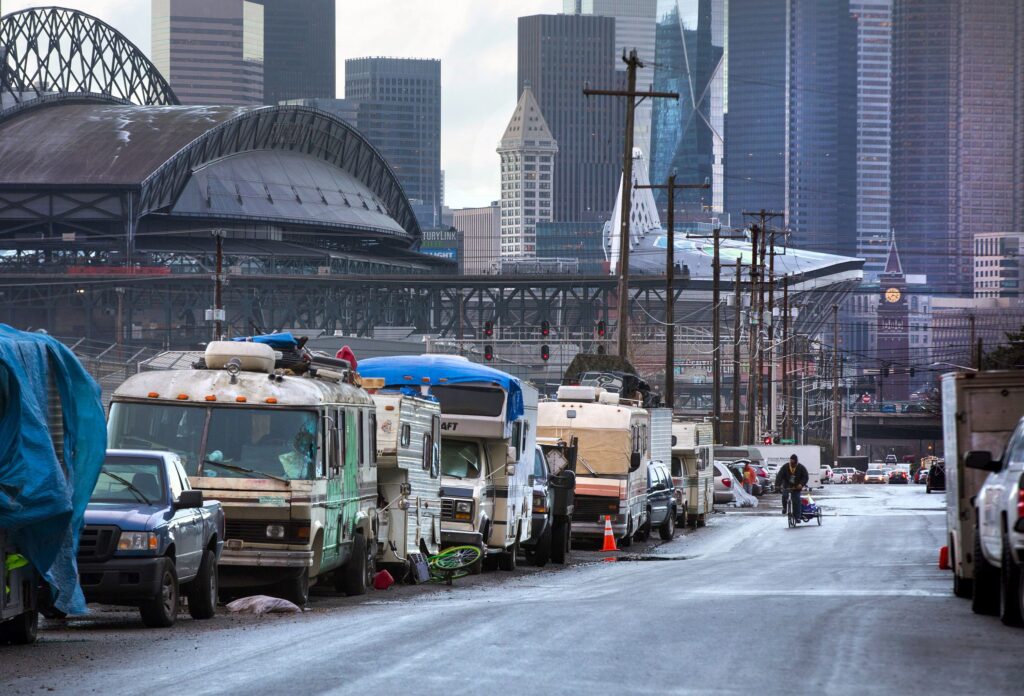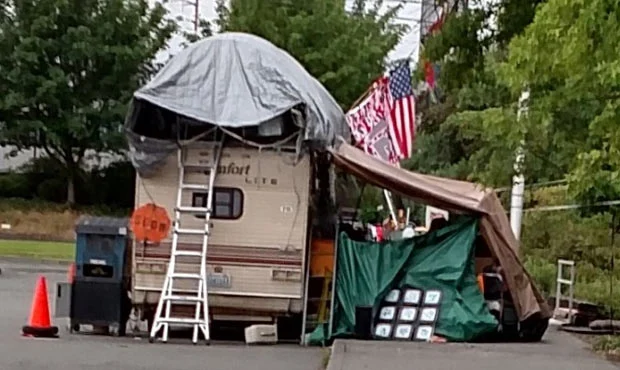One of the shocking things to me during my three-week road trip in the Midwest is that I have not seen one homeless person. Not one!
Over a three week period!
On top of that the issue of homelessness has never once come up in a conversation throughout the 1,200+ mile journey in the Midwest.
It is a non event and a non issue in the Midwest – or at least in the Midwest that I traversed.
What is so startling about this is, by many accounts, homelessness is the number one issue in Seattle, where I started my journey. And that is the case in several cities along the west coast, including Portland, San Francisco and Los Angeles.

How can this be the case? Not one homeless person seen in three weeks in the Midwest. Yet, in Seattle, you cannot travel a block or two in many parts of the city and not see a tent, or a dilapidated RV parked on the street, or a man standing at a red light with a hand scrawled sign begging for a handout.
The rate of homeless per 10,000 population in the states of Iowa, Wisconsin, Illinois and Michigan varies between 7.8 and 8.6 homeless/10,000 population. This puts these states the between the 6th and 13th lowest rates of homelessness among our 50 states. California, Oregon and Washington, on the other hand, have a rate of homelessness/10,000 population which ranges from 30.1 to 40.9. That is approximately 5 times the rates of homelessness in the Midwest. The west coast states rank 3rd, 4th and 5th among the 50 states with the highest rate of homelessness. New York and Hawaii are higher.
Apparently the reason for this difference in the rate of homelessness between the west coast and the Midwest is the availability of affordable housing. The three west coast states in the continental United States have 1,671,435 extremely low income renters. This compares to the 4 Midwestern states who have a total of 1,057,711, almost 40% less than the west coast states.

Nationwide there is a shortage of 7 million rental homes that are affordable and available to “extremely low income renters,” according the National Low Income Housing Coalition. The west coast states have an average of only 27 homes available per 100 extremely low income renters. The Midwest has an average of 37 homes available for every 100 extremely low income renters, almost 40% more than the west coast states.
In addition, I am guessing that there may be some other reasons why I did not see a homeless person during my three week road trip in the Midwest..
For one, my road trip in the Midwest was primarily through small towns and rural areas. The exception was the City of Milwaukee which has a population similar to Seattle’s. Other cities included Dubuque Iowa and Sheboygan Wisconsin, both with populations below 60,000. Most of the towns and communities that I frequented were even smaller. I did not spend time in Chicago, other than to catch a plane.

Two, the weather. Midwest winters are cold and windy. Winters on the west coast are mild in comparison. Midwest summers can be hot and humid, although that was not the case during my recent road trip. Again, the west coast is less hot and much less humid. If you are going to pick a location to live outdoors, most people, I would think, would not choose the Midwest.
Three, the northern European heritage of many of the Midwesterners I believe also may be a factor. People I met in the Midwest had ancestors from the Scandinavian countries of Sweden, Norway, Denmark and Finland. Others had Swiss ancestry. Many others had German forefathers.
When interacting with these descendants from Northern European countries, what came through to me loudly and clearly were a fierce independent streak, a real value in hard work over long hours, an assumption that each person is responsible to take care of at least themselves, and a directness, an honesty, a natural instinct to call things as they see them.
This is not to say that the Midwesterners that I met did not care about those less well off than themselves — that in some way they were not charitable in their thoughts and actions. Not at all. The point, however, is that their first responsibility is to make sure that they have taken care of themselves by working long and hard. They definitely don’t want to be in a situation where they are dependent on others.
Four, I just have to believe that the approach that government takes toward homelessness on the west coast has to be a factor in why there are more visible signs of homelessness than in the Midwest. On the west coast, by and large, the governmental entities will go the extra mile to not disturb or disrupt a person or persons they find in a homeless situation.
The local authorities will presumably do everything they can to find housing for the homeless and to connect the homeless with the appropriate social or health or employment services that can help. Clearly to date, despite this effort the authorities have not been successful in finding enough housing or in connecting with agencies that can provide the assistance needed so that the homeless individual not only has a roof over their head but also has the tools necessary to have a safe and healthy life.
In the meantime, the authorities have decided not to enforce the laws and regulations that exist. For example, in Seattle no car or RV can be parked on the street for more than 72 hours in the same spot. In Seattle, park closing times are posted at each park. Camping is not allowed in city parks except where there is a public campground. In addition there are a host of public health, sanitary and trash rules to be followed.
Nevertheless, the local authorities, by and large, allow these local ordinances, rules and regulations to be violated without consequences if the person or persons are homeless. The result of which is that many local streets and public parks in Seattle are occupied by tents and surrounded by broken down RV’s in disrepair.

These thoughts are just that, thoughts. Speculation. Just trying to understand the reasons for the stark difference in the visible presence of homelessness between the Midwest that I saw on this road trip and what a person experiences and sees in Seattle and other west coast cities.
What are your thoughts?
In New Orleans, since the pandemic, to stop the spread, the city tries to put the homeless in hotels. However some homeless prefer their space under the i10..in tents.. with a portable toilet ..that the city supplies..there are also homeless from hurricane Ida, some of them are out there..there are no dilapidated RVs… Thank God they are not allowed in the parks. The parks are not a place for homeless folks ..Many pan handlers at the red lights, you never know if they just want money for drugs .. or if they are actually starving.. I remember when I was young there just drunks with red faces on the Bowery in N Y C..way back then rents were much more affordable! My grandmother would go to the Bowery to pick up the drunks to work on her dairy farm in up state New York, she had little cabins for these folks behind the barn.. They would sober up and work.. My grandmother would cook large meals for everyone..My grandmother learned to cook in France.. she was some amazing cook..That was before I was 10..
Different politics in the Mid West versus that of the West and East Coasts where “the livin’ is easy” Also not a lot of the near millions of border jumpers that Biden has welcomed, indeed invited over the Rio Grande move to the Midwest. Less drugs in the Midwest, How’s that for a brief synopsis!
Certainly more complicated than that but these are no doubt factors.
Politicians everywhere fall all over themselves pontificating about providing housing for this sector of society, but in reality many would rather live without rules on the street. Defunding police and not enforcing laws only invites more anarchy. Seattle, San Francisco and LA used to be such nice places to visit
In the Midwest the feeling is that it takes a family with values and parameters to raise a child, while there are those that think it takes a village! That concept evolves from other another continent and clearly is a failed model.
Amen to Earl and to Neil. The so called Sanctuary City era welcomed those in need of many services. the impact on budgets and facilities are still escalating